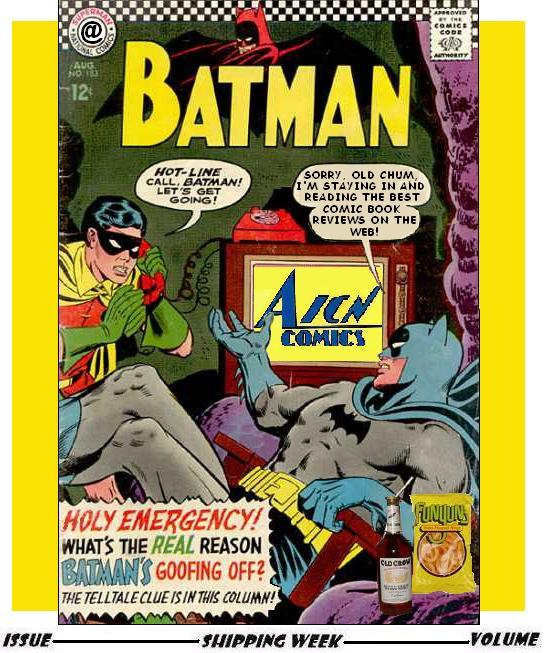
| #5 | 3/10/09 | #8 |
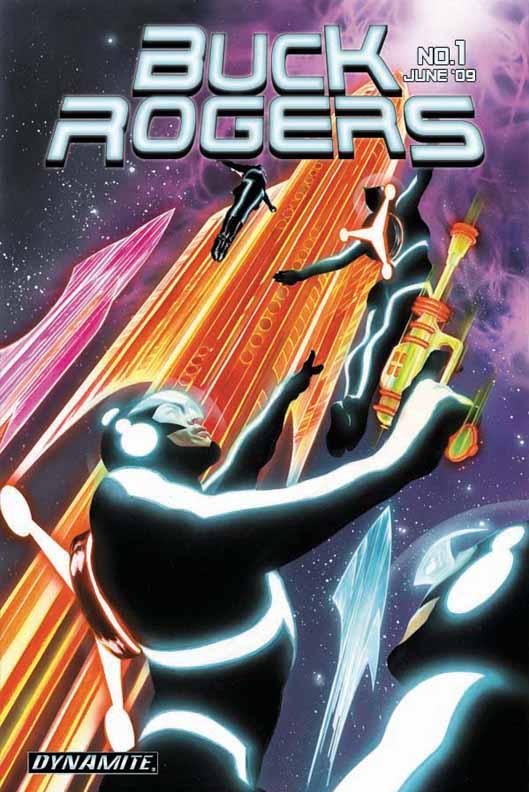
BUCK ROGERS #1
Writer: Scott Beatty Art: Carlos Rafael Publisher: Dynamite Entertainment Reviewer: Optimous Douche
Even though this rebooted BUCK ROGERS avoided the trappings of the 1970s craptacular Disco Buck, please allow me one moment to invoke the spirit of the Gil Gerard’s staccato stuttering cybernetic sidekick Twiki, “I Digga…Digga…Digged this reboot, it was far out!”As a member of Gen X it’s difficult to disassociate this iteration of a modern day man displaced into the far future from the one that made Gil Gerard a comb-over heart throb thirty years ago. For many, Buck was our initial entrance into Science Fiction, for others Erin Gray and Pamela Hensley served as our Aqua Net inspired sexual awakening, and no matter how annoying or condescending, Twiki and Dr. Theopolis established our template for the computers of tomorrow. To say it left an indelible impression with a bitter nostalgic aftertaste would be an understatement.
Thankfully, Dynamite is leveraging facets of a Buck that spoke more to our grandparents and great grandparents. Everything from the style of Wilma Deerings’s space suit and ray gun to Buck’s bravado (Beatty portrays a Buck that is swagger, not polyester sachet) in this reboot harkens back to the old black and white serials. This makes sense considering those that would remember that time period are either dead or just trying to remember who they are, much less who Buck Rogers is. It’s a bold choice to leverage this forgotten period and it pays off way more than a rehash of campy television.
Instead of turning Buck into a dutiful member of the armed forces, Beatty looks at the reality of space flight over the coming years. Space flight has been moving towards privatization for the better part of a decade thanks to the deep wallets of nerds that have done well, so it makes perfect sense that Buck’s experimental plane was crafted in a garage rather on a NASA testing center. This “space flight for profit” model also allows Beatty to give Buck a great present-day foil in the form of the US Government, which shows a keen interest in Buck’s experimental engine that leverages gravity to propel us through the cosmos.
Beatty presents this kick-off issue by treating time like melted fondue, rather than a linear piece of polly-o string cheese, bopping back and forth between past, present and the future with a natural fluidity as Buck traverses past memories while in the vacuum of space (and lies unconscious from crash landings). Quite honestly, the only reason I know Buck ends up in the future is simply because I know the history of Buck; not because it’s spelled out in black and white on the pages. This is a good thing; it not only keeps you guessing, but also helps the reader empathize with the entire fish out of water concept.
When Buck does finally crash land in the future (at least we think it’s the future), he is greeted by Commander Wilma Deering in a sleek anti-gravity uniform and…a bear. Not just any bear, an armed to the teeth talking bear, with a gun that apparently vaporizes both Buck and Wilma.
The two Carlos do an admirable job making every moment of this adventure feel fresh and exciting. Their facial expression work on Buck helps make all of the time spent in the cockpit of Buck’s experimental ship actually pleasant to see, rather than just a vast void of empty black space.
I honestly have no idea where the hell this book is going, but I can say with certainty this is not your father’s (or your grandfather’s) BUCK ROGERS. I know I’ll be strapped in for the ride on issue 2.
When Optimous Douche isn’t reading comics and misspelling the names of 80’s icons, he “transforms” into a corporate communications guru. "What if the whole world had superpowers? Find out in the pages of Optimous’ original book AVERAGE JOE. Read the first full issue on Optimous’ New Blog and see original sketches by fellow @$$hole Bottleimp. If you are a publisher or can help these guys get AVERAGE JOE up, up, and on the shelves in any way, drop Optimous a line."

ABSOLUTION #0
Writer: Christos Gage Art: Roberto Viacava Publisher: Avatar Press Reviewer: Matt Adler
Christos Gage has earned a lot of goodwill from me with his consistently high quality work on such books as AVENGERS: THE INITIATIVE, THUNDERBOLTS, and X-MEN/SPIDER-MAN. As such, when I heard he had a new creator-owned book coming out from Avatar, I wasn’t hesitant to give it a shot. The fact that this preview issue was a $1.99 for 11 pages of story, plus a text piece by the author and 3 pages of pin-ups by Jacen Burrows and Juan Jose Ryp wasn’t too shabby either. Cutting to the chase, Gage doesn’t disappoint here.It’s difficult to discuss this series without spoiling the basic premise, which Gage effectively sets up as a surprise reveal at the end of this issue. So if you don’t want it spoiled for you (and hey, I already told you it’s worth buying) read no further. Ok, you’ve been warned.
We’re introduced to the protagonist, a superhero by the nom-de-guerre of John Dusk, in the context of a dream/flashback to his capture of a Texas Chainsaw Massacre-style killer, albeit too late to save the victims. These memories continue to haunt him.
Gage skillfully weaves the structure of his new superhero universe into the story, providing us relevant details such as the way secret identities operate here, and superheroes’ relationship with law enforcement, without wasting the reader’s time on ponderous info-dump.
In short, John Dusk is an ordinary, respectable member of society whose secret identity is known to his police officer girlfriend and law enforcement in general, with whom he regularly cooperates on solving and prosecuting criminal cases. His testimony is permitted in court without revealing his identity, much the way confidential informants or undercover operatives can be used in real life.
The book’s final reveal is foreshadowed subtly; Dusk is informed by his girlfriend that there’s a serial killer going around knocking off sex offenders, wife killers, etc, and relates her suspicion that it may be a cop, explaining in visceral terms the frustration that cops routinely feel when they see the dregs of humanity get off time and again, free to continue perpetrating their horrific crimes on innocent victims.
“You know how it is for us. Every day, dealing with filth we can’t do anything about. Having to call ‘em ‘sir.’ Knowing they’ll hurt someone. Maybe kill someone. Knowing the world would be better off without ‘em. And knowing how easy it would be to make that happen.”
With this rather emotionally intense scene in mind, when Dusk tracks a suspicious character back to his apartment, who confronts him and freely admits to be a killer-in-waiting, mocking Dusk’s impotence to do anything about it, the reader will most likely realize where Gage is going with this. But by that point, the scene has been so well-set, the suspense and emotion so well-developed, that it doesn’t matter that you’ve guessed the reveal; it still hits you in the gut.
John Dusk, the upstanding, law-abiding superhero, makes the man his latest victim.
In his closing essay, Gage explains how this story was developed; of course, as a writer for “Law & Order: Special Victims Unit”, he has experience writing about crimes that go beyond the pale, but perhaps most intriguing are the conversations he relates between himself and a friend who was briefly a police officer, but quit the force after a year. Much of Dusk’s girlfriend’s speech can be traced to this officer’s experiences (though the actual experiences sound even more horrific and trying on the psyche). This officer simply quit rather than give in to the urges that John Dusk has.
Now that Dusk has chosen this path, where will it take him? What will the consequences be? I don’t know, but if Gage can keep up the intensity level of this preview throughout the series, it should be quite a ride.
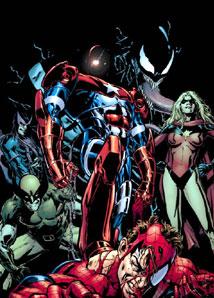
AMAZING SPIDER-MAN #597
Writer: Joe Kelly Art: Marco Chechetto Publisher: Marvel Comics Reviewer: Liam ‘The Kid’
Note: ‘The Kid’ is 8 years old and has been doing reviews on his own site since August of 2008. And you can now follow the kid’s daily ‘adventures’ on Twitter.Peter Parker’s friend Harry is Norman Osborn’s son and Norman wants Harry to join his team of Avengers. Spider-Man has had enough of Norman Osborn being in charge of everything and bothering his friends so he wants to go and stop him. In the last issue he took out Venom in a big fight and the Fantastic Four helped him make a suit that makes him look like Venom. Spider-Man put on the suit and pretended to be the Venom Spider-Man on Osborn’s team.
Everyone knows that Osborn was the Green Goblin and pretty much all the good guys know that Osborn’s Avengers are really bad guys in disguise but no one is doing anything to stop them. I liked that in the NEW AVENGERS comic Ronin went on TV and told everyone that Osborn was evil but all the superheroes should be teaming up to take out the evil Avengers. I’m glad that Spider-Man is doing something to try and stop Osborn and save his friend.
Spider-Man looks cool in the black costume and I like that Mr. Fantastic made it so it works like Venom’s where he grows the teeth and tongue. It was neat seeing the real Spider-Man look like that even if it was just pretend. The best part of the book was when Wolverine’s son and Spider-Man fight. Wolverine’s son is supposed to be as strong as Wolverine and I like the battle they had. The art was really good on those pages, too. My favorite drawing was the one where Wolverine’s son is jumping out to try and get Spider-Man. The only thing I was surprised about was that the match was so close. I thought Spider-Man would be able to win pretty easy but I guess not.
The things that I didn’t like in the book was that there was too much about Harry and his girlfriend and the cover. Harry’s girlfriend is cool when she is turned into Menace but when she isn’t she’s pretty boring and I think she’s lying to Harry about wanting help anyway. She was always wanting to be Menace before to help her dad. I think she’s tricking Harry like she tricked everyone else before. Maybe next issue she’ll turn into Menace and do something. The other thing that I didn’t like was that the cover didn’t match the comic. Osborn isn’t in his Iron Man suit in the comic even though he’s wearing it on the cover. Spider-Man is in his regular suit on the cover instead of the black suit. It’s not a big problem but it’s kind of annoying when the cover doesn’t match the story.
My favorite part of the book was when everyone was calling Spider-Man stupid. It was a little funny the first time someone said it but when he was called stupid the second time it was really funny because it meant that he really didn’t fool anyone. I also liked the fights with Wolverine’s son and Hawkeye.
Rating: 8 out of 10

THE WALKING DEAD Vol. 9: HERE WE REMAIN TPB
Writer: Robert Kirkman Art: Charlie Adlard Publisher: Image Comics Reviewer: Baytor
I’m a new convert to this book and while I don’t think it’s the greatest thing ever, I am enjoying the ride; but I must say I’m glad they’re finally out of that damn prison.There were two big problems I had with the prison arc. The first was the cast got too big for Kirkman to handle properly. It got to the point that anytime I saw a minor character having sex, I started a mental countdown, because their days were truly numbered. I know sex is supposed to equal death in horror stories, but this just smacked of lazy characterization, as Kirkman tried to make the various deaths of the-third-guy-from-the-left have some sort of emotional impact.
The second problem was that it shone a real big spotlight on what rubbish baddies zombies are, making the entire premise seem unbelievable. If a handful of people with no real weapon training and no tanks, body armor, and heavy weapons can run circles around the on-coming zombie hordes, then it’s quite frankly inconceivable that the zombie menace could be so badly handled by the professionals to result in the near extinction of the human race. Oh, sure, there might be a sizable outbreak, but the rules are pretty simple and could be figured out in a matter of days…like the military wouldn’t go for head shots, like they wouldn’t figure out that a bite is fatal and learn to isolate bitten people or amputate infected limbs. And if a zombie can’t get through a chain link fence, what are the chances of one of them crawling out of his grave, meaning that the initial outbreak would be limited to the unburied dead?
But those two problems are (at least temporarily) dispelled as the cast has been reduced to a very manageable number and we’re not seeing how truly inept zombies are at getting through well constructed barricades. Mostly this volume is a collection of character moments. Rick battles a nasty infection and his son must fend for himself. We finally learn who the crazy black lady has been talking to, leading to a bonding moment between her and Rick. And the surviving cast slowly finds each other, which leads into the next big story arc. But mostly this volume returns the book to the ever-present zombie menace of its early days.
I’m still vaguely disappointed in Kirkman’s ability to create memorable and distinct characters. Most of his characters lack a certain spark, so they seldom feel like real people, which is strange in a character-oriented tale. This also leaves a lot of big emotional moments curiously flat. This isn’t much of a problem with his half dozen major characters, but the secondary characters often feel like they’re there just to deliver important information and reveal bits about themselves right before they get killed.
All in all, this isn’t the most eventful story arc in the saga, but it does display the promise of much more interesting things to follow. Let’s just hope that the mullet-wearing conspiracy nut-job scientist is in fact something other than what he appears and our main characters aren’t about to make total fools out of themselves by trusting him.
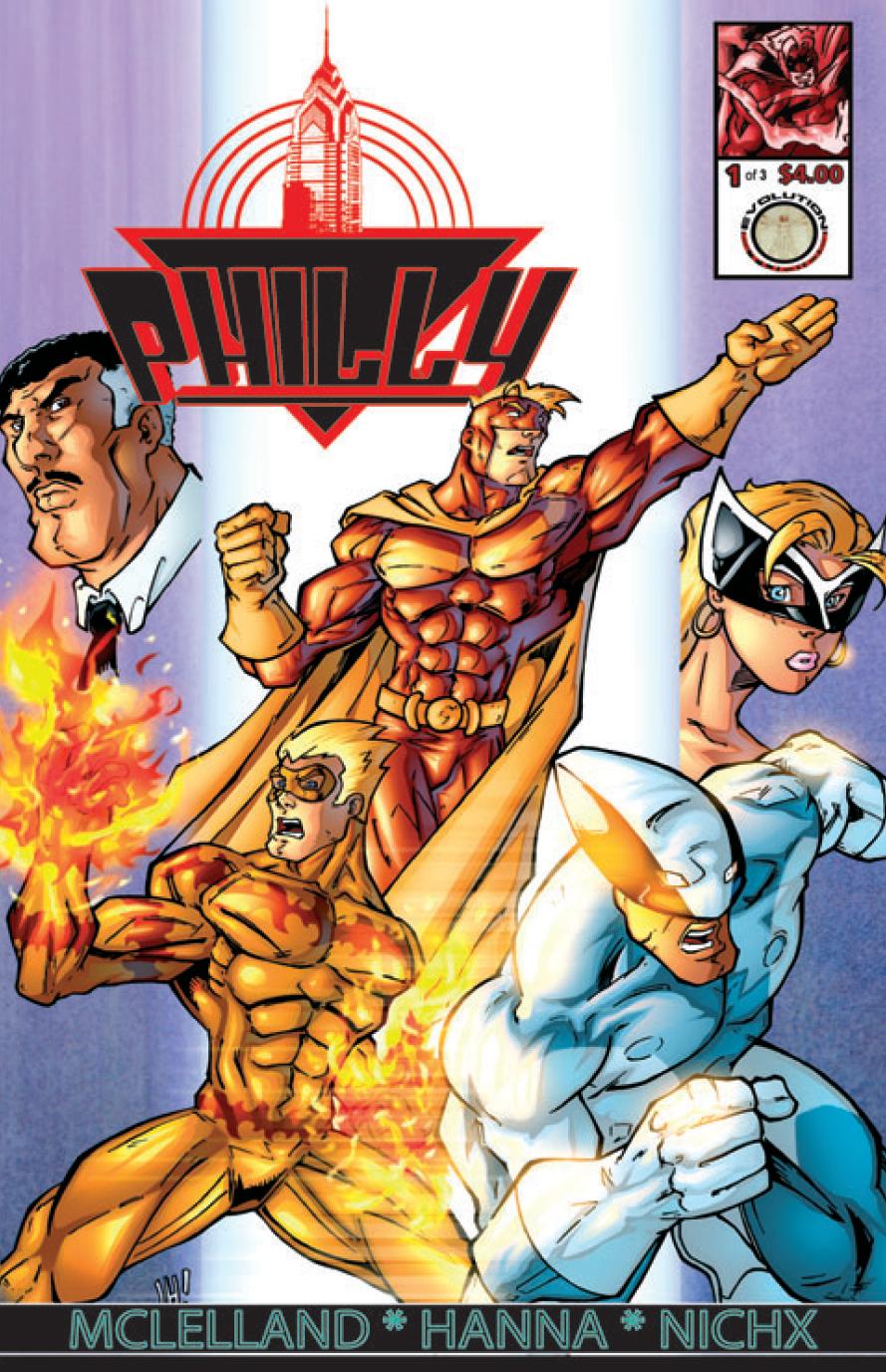
PHILLY Vol.2 #1
Writer: Ryan McLelland Art: Jim Hanna (pencils), Nichx (inks/colors) Publisher: Evolution Studios Reviewer: Prof. Challenger
“Drinking alcohol beefs up my flame powers. It makes me a better hero.” FirestarterA funny thing happened on my way to writing this review. I got all caught up in the story and now I wanna read the next 2 issues to see what happens. What’s funny about it is that when Ryan first contacted @$$hole headquarters and awakened Bug and Sleazy from their nightly spooning, the @-signal was quickly sent out for someone to review PHILLY Vol. 2 #1. After a few days of more excuse-making than a group of potential jurors, I stepped up and said “Oh wtf, I’ll do it.”
So, here I am and I was all prepared to eviscerate Ryan’s efforts here in an effort to prove how impartial I am. But dammit, before I realized what was happening I was enjoying the stupid thing. Now, anybody who’s read Ryan’s reviews knows he’s got a sense of humor, and to tell the truth, when I first started digging into it I could hear that same silly, snarky voice of Ryan’s coming out of the mouth of the Firestarter character. So, I was already smiling a little. But I think it was about the point where the hero had just broken the neck of a vampire and was yanking a fang out in an effort to get the vamp to tell who his leader was that I realized I had stopped thinking about Ryan and was just all into the comic itself.
The bottom line on the comic is that it made me laugh, and I mean that in a good way. This thing is pure subversive snark and a fun little distraction from the way too serious Big Two. I mean, the idea of a drunk super-hero telling his secret origin to the bartender to get more free beer is just a funny idea and then to have the bartender disbelieve the story? Priceless.
I’m not going to say this comic is profound or deep; it’s not IRREDEEMABLE. The characters, however, are rather rogueish and a bit egotistical and they bicker a lot. But I kind of liked them, and I think Ryan is hoping readers will like them, and that goes a long way toward enjoying a comic like this. Now, surrounding these three heroes with vampires who would fit in well on any episode of BUFFY is a treat. In fact, these vampire characters sound and act more like BUFFY-style vampires than they do in many a BUFFY comic book. Super-heroes versus Vampires almost always equals fun. The only way to make it more fun? Add werewolves to the mix. Am I right?
You can tell Ryan is a fan of comics first and foremost, because he’s throwing everything that’s cool about an indie comic here with some gore and blood, some liberal cursing, gay jokes, mocking of authority, flouting super-hero clichés, and even some silly drunk super-hero stuff. And for some reason, at least to me, it makes it all even funnier by being set in Philadelphia instead of New York, Chicago, or LA. Why is Philly such a funny city? There’s also a sexy tease for the straight crowd in that the cover features a female hero with a “Mockingbird” mask, but she doesn’t actually appear in this issue…well, other than a sexy pin-up. So, I’m guessing that this trio of heroes is soon to be a quartet.
Artistically, the guy providing the art is Jim Hanna. Now, I’m unfamiliar with his work but what I like about it on this project is the sense of whimsy. It’s a style similar to a lot of mainstream independent work (think DEAD @17). But Jim brings a little something that I really appreciate and that is a bit of a look like he’s inspired by the great Joe Staton of E-MAN fame. That face shot on the cover of the Philly Police Chief is pure Staton.
I should probably get off my lazy ass (but won’t) and do some research into the background on this series since it is identified as a “Volume 2.” So, that probably means there’s a “Volume 1” out there that I’ve never heard of. But the joy of the new information age is that teh InterWebs is a great way to get your hands (or eyes) on cool stuff like PHILLY that may not be carried in your local comics store.
I’m sorry, Ryan and Bug. I really did intend to tear this comic apart but instead I kind of dug it. Sorry.
PHILLY is also apparently a comic that can teach me important things. It taught me that gay humans and vampires both have one thing in common: a love of “Gossip Girl”. See? I did not know that, and never would’ve known that were it not for PHILLY. So there’s that.
Prof. Challenger is really Texas artist/writer/editor/researcher/teacher Keith Howell, who recently successfully battled the evil airline industry as he struggled to trek across the great mid-west to Peoria, Illinois where he received the 2009 Farmerphile Award for Best Artwork at FarmerCon IV: The Philip Jose’ Farmer Memorial Gathering. Check out his website which is badly in need of updating at profchallenger.com. and check out all things Farmer at pjfarmer.com. Yes, it’s true, there really are some people who actually like the Prof.
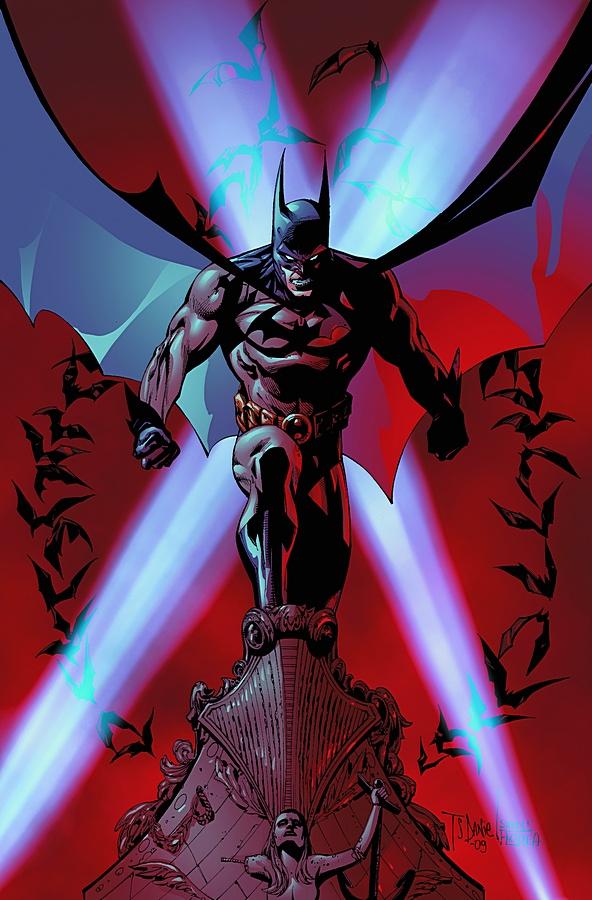
BATMAN #687
Writer: Judd Winick Art: Ed Benes Publisher: DC Comics Reviewer: Ambush Bug
WARNING: If you are offended by the word “dick”, you may want to scroll past this review. Be forewarned, henceforth there will be a lot of dick talk.Although I wouldn’t call myself a fan of writer Judd Winick’s work, I don’t have the usual aversion many experience when the writer’s name is mentioned. Winick’s been around for a while and though he definitely deserves some of the interweb backlash he receives, I’ve read a couple of his efforts that haven’t been as bad as some seem to want to say. I have noticed that when Mr. Winick steps from the soapbox and doesn’t try to tell a story with a special message, his work tends to be stronger. I think it’s those “very special issues” by Judd Winick that leave such a bad taste in the mouths of some of his detractors. For instance, the John Walsh cameo from his OUTSIDERS series was forced, preachy crud. But on the other hand, I found quite a few of his issues of GREEN ARROW to be fine adventure yarns (when he wasn’t using Connor Hawke as a crash test dummy, that is). One thing I’ve noticed is that some of Judd’s strongest mainstream super hero work has been when he’s writing Batman. Not sure why, but when he’s writing about The Cape & the Cowl, he ups the ante a bit and the bet pays off here.
Now, I’m not going to say that this issue is anywhere near the quality of Morrison’s pretty damn sweet BATMAN & ROBIN #1 issue. But after reading Tony Daniel’s fun yet breezy BATTLE FOR THE COWL, its good to have Winick on board because he does know how to craft a decent Bat-yarn. Before you race to the Talkbacks to tear me a new one, hang tight and read on. This isn’t a perfect issue and I’ll get to the problems in a bit, but I want to start this on a positive note.
What I liked best about this issue were some of the quiet moments. There’s a scene where Wonder Woman and Superman are in the Batcave and ask Alfred if he is alright. Alfred responds bluntly and somberly, “No, sir. I am not. My son has died.” This was a quiet scene that could have and should have been in the ga-billion and one books after Bats “died”, but it wasn’t, so it was good to have that acknowledged here in a scene that really is pretty well executed. There’s another scene at Bruce’s “funeral” where Dick discourses about how there shouldn’t be a big funeral for Batman or parades in his honor. It would ruin the myth and the effectiveness of all Bruce has built. These are necessary scenes. Sure some of them are redundant (especially since Dick merely parrots what Alfred tells him pages before in this scene), but one thing Winick does well is write emotions. He’s not afraid to show the wear and tear this super hero business has on a character. Falling back on Winick’s strong suits, these key scenes of the book were the best of the bunch.
Unfortunately, there were quite a few more pages in this book, and a whole lotta them were redundant.
The main problem with Winick is that he occasionally doesn’t know when to quit with the touchy-feely stuff. It’s good to be in touch with one’s emotions. It’s good being able to express them from time to time. But when it happens all the time, well…that’s not entertaining; that’s a therapy session. Twice in this issue, we get mopey Dick slumped over or gazing heroically off into the distance, gripping the cowl and furrowing his brow, hemming and hawing about whether or not he wants to put on Bat’s spare pare of underoos. Now, this wouldn’t be annoying if not for the fact that Dick has been doing this since Morrison’s first “false” death of Batman at the end of R.I.P. (circa December of last year) OR spent the last two months doing it in every issue of BATTLE FOR THE COWL and its myriad spin offs and tie ins. Let’s not even mention the scheduling mess of releasing BATMAN & ROBIN a week prior, which makes the big reveal in this issue completely meh inducing. But in this issue, we get more pontificating from Dick about how much of a tough decision this is for him. We get it, Dick. Shit or get off the pot, already. Seeing a character mope and whine about something, then getting a fine issue of BatDick and Robin from Morrison only to have more mopey Dick a week later is just short of maddening.
So I’m conflicted with this issue. It’s got a few nice scenes. Necessary scenes. Scenes that help bridge the gaps that often Morrison doesn’t want to be bothered with in his broad-strokes storytelling style. I appreciate Winick’s deft and careful handling of said key scenes. But I hope that now that we’ve finally got Dick in the costume we can have him do something more than just poke at being Batman like a skeeter on a streetlamp. These scenes weren’t all bad, some of them were necessary and well done. But I’m glad they’re behind us so we can all move on with some stories featuring the new Caped Crusader. And while I don’t love all of Winick’s efforts, I have been entertained by his Bat-stories the most out of all of them, so I’m willing to give his run a shot here. With Ed Benes’ solid art sweetening the deal, this book may not be the blockbuster BATMAN & ROBIN is, but it has potential to be a good read if Winick uses the emo in moderation and the book is allowed to fly on its own rather than simply fill in the holes Morrison lacks the attention for.
Ambush Bug is Mark L. Miller, reviewer and co-editor of AICN Comics for over eight years. Check out his short comic book fiction here and here published in MUSCLES & FIGHTS 3 and MUSCLES & FRIGHTS on his ComicSpace page. Bug was interviewed here and here at Cream City Comics. Look for more comics from Bug in 2009 from Bluewater Productions, including the just-announced sequel to THE TINGLER for their VINCENT PRICE PRESENTS series available in July’s previews and on the shelves September 30th.
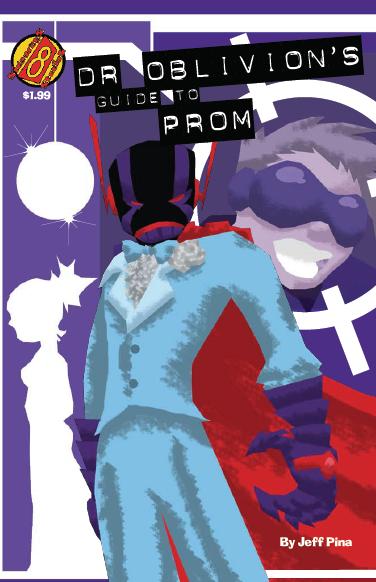
DR. OBLIVION’S GUIDE TO PROM #1 (one-shot)
Written and Art by: Jeff Pina Published by: Sideways 8 Studios Reviewed by: Ryan McLelland
It’s a pretty rough life being a supervillain. It’s also pretty hard being a father to a teenage daughter. It really sucks being a supervillain who is also a father to a teenage daughter who also happens to be dating your heroic nemesis. Thus is the life of Dr. Oblivion and the good Doctor is back for more (after the incredible mini-series DR. OBLIVION’S GUIDE TO TEENAGE DATING) with the brand new one-shot DR. OBLIVION’S GUIDE TO PROM.Dr. Oblivion is now leading a nice retired life following the events of TEENAGE DATING, though he is not happy about his daughter Callie going to the prom. She’s not going with The Mongoose – her beau and Oblivion’s rival but Oblivion knows that something must be amiss between the two lovebirds. So he does the normal thing a father would do – he chaperones. His chaperoning only lasts moments as he is booted from the prom for being a bit overbearing about EVERYTHING. This leads him to don his costume once again and decide to bring on the killing, starting with that pesky Mongoose. Death, robots, costumes, and destruction? Sounds like an awesome prom to me.
Jeff Pina writes and draws another great Dr. Oblivion book, a twisted Mangaesque witty tale of being a jealous father who not only will say, “Treat me daughter bad and I’ll kill you” but will actually back up that threat. My big gripe? The issue is way too short but the price is appropriate for that making this issue a great affordable buy (especially for those who might be interested in the Dr. Oblivion but don’t want to spend a lot). DR. OBLIVION’S GUIDE TO PROM is a great new entry into this delightful series and will instantly make a fan out of anyone who picks it up.
Ryan McLelland has worked in movies and comics journalism for the past several years before joining the @$$holes here at AICN. Ryan’s comic work has already graced comic shelves with Arcana’s PHILLY, WISE INTELLIGENCE, UPTOWN GIRL, and THE SENTINELS ANTHOLOGY. He rarely updates his blog but when he does it can be read at www.eyewannabe.com. The first issue of his new WISE INTELLIGENCE miniseries can be found here.

FANTASTIC FOUR #567
Writer: Mark Millar Art: Brian Hitch Publisher: Marvel Comics Reviewer: steverodgers
Mark Millar really knows how to write a comic book, Bryan Hitch really knows how to draw one and together they really get the job done. Issue #566 of FANTASTIC FOUR starts things off with a beautifully-rendered, beached, dead Watcher, and Reed doing CSI stuff on him surrounded by unspecified agents. It actually felt a little DC, starting it all off with some galactic mystery. Reed is asked by Agent Nong what could kill a Watcher, causing Reed to stare off into the stretchy distance, in pensive but manly silence and finally say, “You don’t want to know.” This is movie star stuff and Millar and Hitch are cinematic in the way they do comics; it’s moments like that—pure-Hollywood-popcorn movie scenes—that make you want to get yourself a movie Coke to go with it. It worked well in the ULTIMATES, and it’s really starting to work in these past two issues of the FANTASTIC FOUR.In this issue we also meet Doom’s master (who looks like Judge Death) and his apprentice (who has a cool scepter and looks to be wearing Doom-ish armor). The Master is upset with Doom: Doom isn’t evil enough; he is in charge of a tiny country he has never heard of; he is squandering his talent and isn’t living up to his potential. The Master is like an angry, naggy parent holding up a sub-par report card from villain school. So angered by Doom’s performance, the Master fries him up with some magic bolts.
Now, there are a couple ways that I’m looking at the premise of “Doom’s Master.” One is that Doom really has no master, that the whole concept is total nonsense and it’s just Millar shoe-horning and changing characters into a plot to make it work. But the other way, and this is what’s working for me so far, is that if this guy is really Doom’s master, then he must be something really powerful—so powerful that even Doom is awed; and if that’s the case, the Fantastic Four are really in for it.
In #567, Doom’s master joyfully toys with Doom by expertly mindfucking him up and down, dumping his burnt carcass into the Pliocene age to be eaten by a big dinosaur whale and turning Latveria into Genosha. It’s really over-the-top, massive, comic book destruction beautifully drawn by Hitch. It’s pretty scary actually; the Master means business and now that Doom is out of the way, he decides to take up Doom’s mask and give his foes a real challenge, starting with the Fantastic Four. It’s classic comic booking: just when you think your worst enemies can’t get any worse, someone a whole lot worse shows up.
I’m excited to see what happens next, even if I probably know what will happen: Doom will get himself together, the Fantastic Four will be pushed to the brink, and when all hope is lost, they’ll somehow manage to be heroic, make hard choices, maybe team up with a reluctant Doom and save the day. And really, isn’t that about all you could want in a well done, summer-Hollywood-action, super hero comic?
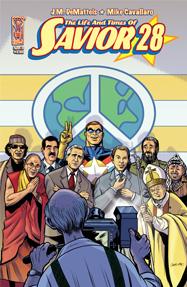
THE LIFE AND TIMES OF SAVIOR 28
Writer: J.M. DeMatteis Art: Mike Cavallaro Publisher: IDW Publishing Reviewer: BottleImp
When I read the first issue of this series, I remember thinking, “It’s okay, but SAVIOR 28 is just another superhero deconstruction title to toss on the pile.” After two subsequent issues, this comic book has jumped up from that gray area and become one of my favorites. Here’s why: there are usually two directions that this medium tends to go to when dealing with the real-world ramifications of muscle-bound, atomic-powered vigilantes who wear their underwear over their pants. At one end we have the REALLY real world (as with WATCHMEN) where the mere existence of superheroes, let alone their actions, has a profound effect on the political, social and economic conditions of the entire world. At the other end lies the more “comic book-y” world (such as the universe of Mark Gruenwald’s SQUADRON SUPREME) where the superheroes can save the world from alien invaders, blow up mountains with energy blasts from their eyes, but not have any effect on the day-to-day workings of their world, until the superheroes make a conscious decision to (everyone together, now) use their powers for the betterment of mankind.The thing that makes SAVIOR 28 so interesting is that it manages to fuse both these familiar themes into a single story, so that Savior 28 is negotiating peace talks with foreign dignitaries at the same time that crazed super-villains are plotting to conquer the world. It sounds goofy, and it shouldn’t work, but somehow J.M. DeMatteis has managed to blend the intrigue of real-life politics with the absurdity of the four-color hero and make it seriously compelling.
That’s pretty damn cool.
This issue (narrated by Savior 28’s assassin and former sidekick) focuses on the start of the peace movement begun by the hero after his failure to prevent the 9/11 attacks. We get some of that Alan Moore-style real-world impact as Savior 28 tours the world meeting presidents, prime ministers, dictators and despots. We get the reaction from the George W. Bush White House to 28’s visits with America’s enemies in the “War on Terror.” And unlike all those Obama comics that were obviously produced as a quick marketing gimmick, wherein Obama’s politics or policies have no bearing on plot or tone, the inclusion of the political figures in SAVIOR 28 is essential to that real-world feel that DeMatteis achieves. And of course, because no superhero comic would be complete without it, a crazed super-villain crashes one of 28’s peace rallies.
But it’s not your usual slugfest—instead of a simple victory through strength scenario, we’re presented with disturbing questions about the effectiveness of peace rather than combat, the ability to turn aside when confronted by enemies, and our instinct as Americans (or even as humans) to cheer for violence. All this wrapped up in a seemingly innocuous fight scene.
Don’t get scared off by all this philosophical talk—there’s still people in costumes, hints of a big government/superhero conspiracy, and the added menace of one of 28’s arch-enemies trying to seduce him to her cause. In other words, there’s plenty of that good old comic book action that makes the medium a hoot to read. SAVIOR 28 is shaping up to be the best of both worlds—the superheroes and the serious—and fans of either genre would do well to give this title a try.
When released from his Bottle, the Imp takes the form of Stephen Andrade, an artist/illustrator/pirate monkey painter from the Northeast. You can see some of his artwork here. He’s given up comics more times than he can remember. But every time he thinks he's out, they pull him back in.
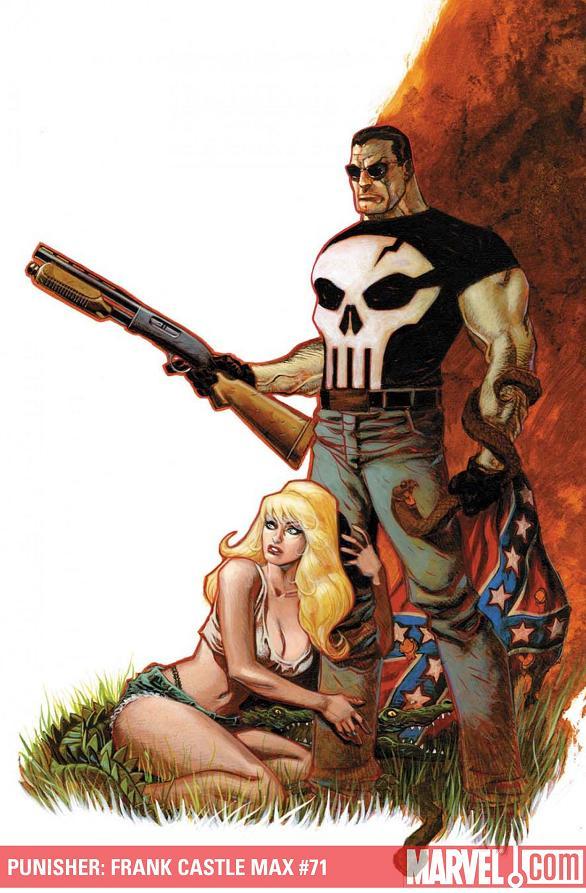
FRANK CASTLE: THE PUNISHER MAX #71
Writer: Victor Gischler Art: Goran Parlov Publisher: Marvel MAX Reviewer: Mr. Pasty
“This place looks like a fucked-up version of Cracker Barrel.”How do you reinvent a homicidal vigilante who’s butchered the crime-ridden streets of New York for over 30 years? Why, you load up his trunk and send him on a road trip, of course. WELCOME TO THE BAYOU is probably the most offbeat and entertaining “Hero vs. Hick” storyline since Spider-Man went toe-to-gangrenous-toe with Banjo and Bugeye back in SPECTACULAR #156.
Frank Castle is headed to New Orleans to deliver a package in his trunk. And when I say package, I mean the sort of cargo that thumps and bumps down the highway ala Billy Batts. Fortunately, Victor Gischler’s script is in no hurry to get him there. That means plenty of soliloquizing and Hillbilly hijinks along the way. In fact, all the southern stereotypes are here in earnest: drunk driving, southern belles, man-eating alligators and of course, denim overalls stretched over hairy backs. This book is loaded with characters that are so vile and so country, even Swamp Thing is talking to a realtor.
THE PUNISHER MAX series has struggled to live up to the legacy of Garth Ennis since his departure in 2008. “Welcome to the Bayou” is no exception. Gischler has managed to capture the spirit of Frank Castle, but not his heart and soul. Still, I don’t consider it a total loss, especially in the case of his trip to “The Big Easy.” This Castle is a little looser and at times, more accessible. Yes, he broods and yes, he talks to himself like Micro can still hear him, but every now and then I like to get through a Punisher book without feeling the need to blame his sins on the memory of his dead kids. This is one of those times. I hate to sound unsympathetic, but the Castle family has been gone for many years. I’m kind of over it.
Parlov’s Punisher is appropriately menacing. Think Duke Nukem minus the silly dye job. He also has a gift for drawing scantily clad women. (C’mon baby...kick them Daisies…) I would only ask that unless Frank Castle is going to change back into Clark Kent at the next phone booth, let’s do without the spit curl. “Welcome to the Bayou” is a promising start in a new direction without abandoning the blood and guts storytelling we’ve come to expect from the Punisher MAX series. Bottom line? This story delivers. It’s all the fun of “Redneck Rampage” without any of the headaches of DOS.
My Rating: 4 Southern Comforts out of 5
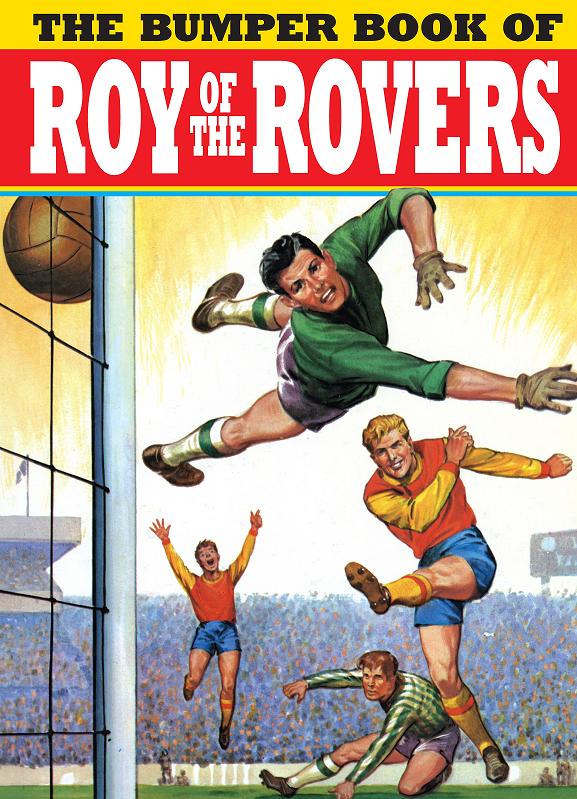
THE BUMPER BOOK OF ROY OF THE ROVERS HC TPB
Writer: Various Artist: Various Publisher: Titan Books Reviewer: steverodgers
About 10 pages into the BUMPER BOOK OF ROY OF THE ROVERS, it became clear to me that reading a comic about soccer is about a gazillion times more interesting than actually watching it played on TV. This book is a compilation of strips, old advertisements and pages of soccer fiction from the 50s, 60s and 70s British Annuals about Roy Race and the Melchester Rovers, which young English lads apparently used to gobble up once a year. The book is absolutely charming and, I have to say, there is something about a ballclub being kidnapped on its way to a match, taken to a castle and forced to play and outwit some robot soccer players, which just transcends sports. In this book, Roy and his mates play football (of course), have adventures, show some local boys around the team facilities and meet the trainer (there are pages and pages about the team trainer) and enjoy a working holiday before the season starts. It is full of soccer minutia and illustrations of the team hot pool and jerseys from around the world; if you are into soccer, it’s in here.The art is illustrative, like an old magazine advertisement in LIFE magazine, and Roy and his pals look gallant as they strut around the pitch, making sure to play to win, but to play fair. The advertisements are just as fun as the stories, with boy commandos in their Clarks Commando shoes who help solve a mystery. Also, check out the Action Man Footballer in your favorite team’s colours, and if you send in 15 stars from your Action Man figure set you get a free Action Man tie!
This is the comic for you if you know who Roy is and read his adventures over a plate of fish and chips or have some massive love for soccer (you know, if you’re British). But it’s also for the Yank like me who loves to pore over the letter pages, advertisements and quirk in old comics—and it’s even more interesting with another culture. It’s a shame they didn’t have this in the States; as a kid, I would have loved to have followed a fake NFL team in comics. Sure, there was KICKERs INC. (which I bought) and NFL SUPERPRO (did not buy), but this is something more; it’s part instruction manual (the lads instruct us on how to kick and we learn about off-sides) and part idealist, happy-to-have-a-straight-laced-sports-hero comic. It’s just very…charming.
As someone new to Roy, I would have loved to have an introduction (where is Neil Gaiman? He’d knock that out of the park) and more information on the artists, writers and historical information behind the stories; for, as it is, all the artists and writers are anonymous. Other than that though, this is a nice time capsule worth opening. You’ll feel the thrill of watching the lads head out into the pitch and the shouts of the home crowd, with old Roy, handsome, smart and ready to lead the Melchester side to another victory!
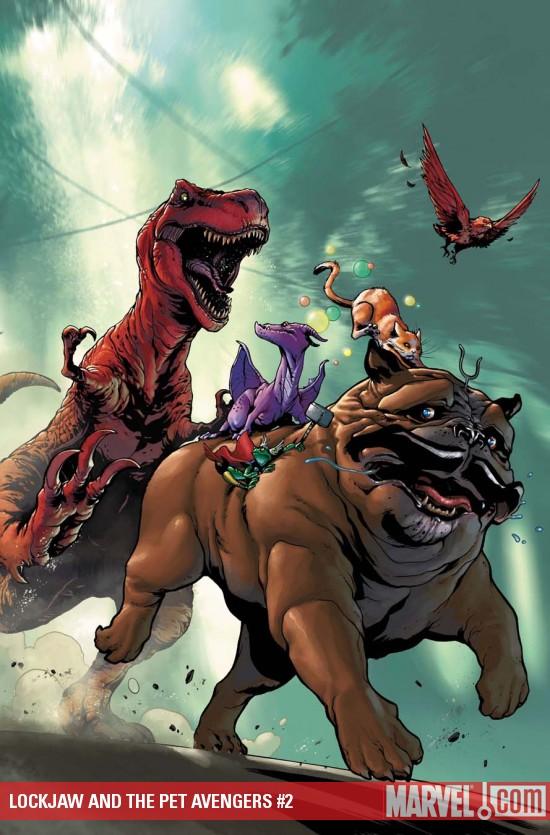
LOCKJAW & THE PET AVENGERS #2
Writer: Chris Eliopoulos Art: Ig Guara Publisher: Marvel Comics Reviewer: Matt Adler
This is a very silly comic. But that’s okay. With tons of doom, gloom, and mayhem on the shelves, it’s a nice change of pace to have a comic about a bunch of superheroic animals on a quest to recover the most powerful objects in the universe.Chris Eliopoulos has distinguished himself with his all-ages work at Marvel on such books as FRANKLIN RICHARDS: SON OF A GENIUS (though that’s not all he’s capable of, as anyone who’s read his DESPERATE TIMES series knows). Here he gets to draw on a surprisingly diverse cast from across the Marvel Universe; I never really thought about how many super-powered animals Marvel has before this series, but I suppose that’s not a topic many dwell on.
As in the first issue, the team is led by Lockjaw, the Inhumans’ gigantic teleporting dog, who has gathered his group of powered pets to retrieve the Infinity Gems (of Thanos and his Infinity Gauntlet fame) before anyone less responsible than said group of animals gets their paws on them. Interestingly, Eliopoulos chooses to have Lockjaw be the one member of the group who never speaks directly, perhaps in reference to his silent master Black Bolt (and perhaps also in reference to the long-standing controversy over John Byrne’s retconned retcon of Lockjaw being a mutated Inhuman rather than just a smart dog).
Fulfilling the role of Medusa in speaking for Lockjaw is the Frog Thor, Eliopoulos’ (re)creation from the pages of Spider-Man Family (and an homage to Walt Simonson’s classic Thor tale). The cast is rounded out by Lockheed, Kitty Pryde’s alien miniature dragon who is still mourning the loss of his mistress; Redwing, the Falcon’s telepathic falcon; and Hairball (AKA Niels), Speedball’s kinetically-charged bouncing cat, and the non-powered Ms. Lion, Aunt May’s pooch. It’s thus far unclear if Hairball is aware that his master has turned into a spiky emo masochist (though it’s been reported in interviews that Speedball is on his way back to his more traditional form, so that may be moot, and is probably not appropriate to the tone of this series anyway).
This installment sees the Pets transported to the Savage Land, where quite naturally they add Zabu, Ka-Zar’s sabertooth tiger to the team, and the surprise antagonist turns out to be Devil Dinosaur. Probably the most amusing part of the issue is the constant back and forth between the few-cards-short-of-a-deck Ms. Lion and Hairball who is completely disdainful of this dog who compensates for his (yes, Ms. Lion is a he) lack of powers with tons of enthusiasm.
This is very much an all-ages book in terms of the content being acceptable and accessible even for younger kids. Adults, if they can accept the sense of whimsy and innocence with which the book is written, will find something to enjoy too. It’s by no means a biting or sharp satire, but it’s sweet, and it’s fun.
ICONIC OGN
Writer: Various Artist: Various Publisher: Comicbook Artists Guild Reviewer: Prof. Challenger
"CAG is pretty terrific. One of the hardest parts of the freelance creative life is the isolation. Freelancers generally work alone. It's rare to have a chance to interact with a bunch of other "creatives" and see what happens. CAG provides that chance for newbies, experienced creators, artists, writers, dreamers…generally there's a lot of talent in the room. Stuff happens…" Gary CohnFirst of all, who or what is the Comic Book Artist's Guild?
Thank you for asking.
The Comicbook Artist's Guild is a loose group of folks who work together to promote independent comic book artists/writers and their creations. This means creative people and those who are simply fans working together to explore new artistic possibilities within the medium and work toward giving comics a good reputation within the communities we all live in. So, join up with them. Friend them on Facebook. Purchase a copy of this anthology. This is an easy and real way to become involved in comics beyond just being a consumer.
Now, some of you may remember comics like BLUE DEVIL and AMETHYST: PRINCESS OF GEMWORLD. I know I do. Those two series came out right in the middle of my glory days of comic book collecting (read: high school) and so I'm very familiar with writer Gary Cohn, who wrote or co-wrote (with Dan Mishkin) both those series and many other comics of the day. Gary now teaches full-time and helps with CAG as a labor of love and contributes to this anthology with a nice introduction about the roots of ICONIC. Reflecting back on his childhood, he shares common memories with myself and probably many of our generation. For example, we share the expansion of our vocabularies because of the purple prose of Stan Lee. Many a time I also found myself thumbing through a dictionary so I could understand what The Beast was saying. Another shared experience is that exposure to Marvel's THOR comic directly led to an interest in mythology. For myself, it was 3rd Grade that the characters of Thor and Hercules from THE AVENGERS led me to the school library in Puerto Rico to check out a book on Norse Mythology and Greek Mythology. And I've been hooked on classical and modern mythology ever since, and all thanks to comics.
ICONIC is an anthology of short stories that all share a common theme. They are all in some way presenting a story about a legendary or iconic hero (real or fictional) but the telling of the story is somehow skewed or twisted. The stories are held together by a framing sequence involving a grandfather reading these stories to his grandchildren (evocative of the framing sequences in the film THE PRINCESS BRIDE). There are ten stories in all and each one is unique and enjoyable. I will highlight three of them to give you a taste of what is available within the pages of ICONIC.
FIRST IN FLIGHT: THE STORY OF GUSTAVE WHITEHEAD tells the story of the actual first sustained flight and the man who lost out to the Wright Brothers because of history's rewrite and a bit of anti-German sentiment. Written by Robert Sodaro and brilliantly illustrated by my friend Rick Lundeen, who most recently published 100 COVERS (an excellent book itself). Rick is one of those professional working artists with a profound love and appreciation for comic books but who inexplicably has never been snapped up by one of the two major publishers. His artwork made for a strong first story in this anthology.
Next I would like to focus on GEORGE & THE MONSTER, written by Scott Ludwig and illustrated by Keith Murphey. What a joy of a story. Scott takes the classic tale of St. George & the Dragon and transplants it to a modern day boy (George) battling the monster (Dragon) in his closet. What impressed me artistically was that Keith is also the illustrator of a brief biographical short about Mark Twain in this same book but used two completely different styles. Keith used standard realistic graphical illustrations for the Twain piece but then he shifted to a style reminiscent of the cartooning work of Phil Foglio for the GEORGE story and I really loved it. It is probably my favorite of the stories.
REPERCUSSIONS is a Sherlock Holmes versus Jack the Ripper story with a rather unsettling twist at the end. This story is well-written by Dwight Baldwin and is illustrated in sharp blacks and whites by J.M. DeSantis. I really thought J.M.'s slickness of line and strong harsh shadows added a nice mood to the story.
But these three highlights from me do not fully cover the range of stories that include (but are not limited to) a story about John Henry, a cool interpretation of A CHRISTMAS CAROL, and a nifty take on Jason & the Argonaut's encounter with Talos the Bronze.
I hesitate greatly to criticize a book like this that is a true labor of love, so I'm not going to do that. But in truth, there's not anything I need to really criticize, though the more experienced connoisseur of comics will probably note the wide range of artistic experience within this book. The editor rightly uses the most experienced and polished artists to produce the framing sequence and the first few stories. This helps the reader to get into the book quickly and buy into the concept and keeps the shifts in style and ability from being too jarring. But the truth is that each and every story is outstanding in its own way and makes this an anthology well worth owning and reading more than once.
To be sure, this is a book that can and should be enjoyed by readers of all ages. If you choose to get a copy, consider enjoying it for awhile and then donating it to your local public or school library. Or better yet, buy one to keep and one to share. The more we fans support efforts like these, the stronger the comic medium will become.
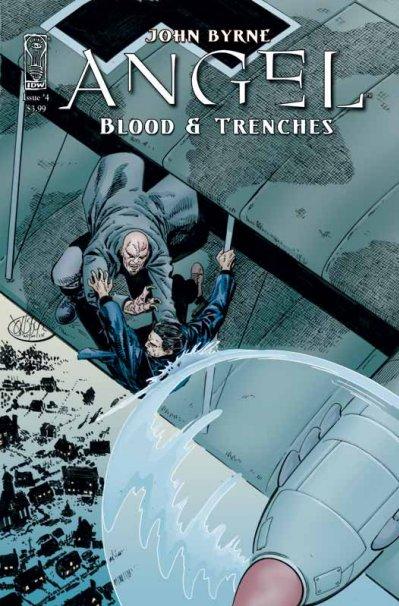
ANGEL: BLOOD & TRENCHES #4
Written by: John Byrne Art by: John Byrne Published by: IDW Publishing Review by: Baytor
This mini-series started with a really interested image: a vampire flying a German triplane. It’s the sort of image that makes you wonder what those nasty vamps are up to and as I headed into the fourth and final issue of this mini-series, I was hopeful that Byrne would reveal a twist worthy of that set-up.He doesn’t. Kakistos isn’t trying to raise an army to invade hell. He’s not trying to bring down a rival demon. He’s not looking to even an old grudge with the Watcher’s Council. All he’s doing is planning an air invasion of London while in the employ of the Kaiser for unspecified reasons (an odd plan for an old-fashioned vampire who shunned all modern conveniences, including electricity, in his one and only BUFFY appearance), which might be enough if the story focused on what a devastatingly bad thing that would be, but we’re not even treated to the usual ranting monster talking about how he’s going to feast on the blood of King George and use his skull as a goblet.
In lieu of interesting revelations, we get a lot of overly-dramatic first person captions as Angel exercises his purple prose muscles and sleep-walks through some fairly pedestrian escape sequences leading to the big, climatic battle atop the wing of a German plane…a battle that doesn’t come anywhere close to the level of excitement and danger promised by the cover. Byrne’s continued ineptitude at non-linear storytelling added some unnecessary confusion to the entire affair, which had me re-reading the previous issues to make sense of the timeline and plot. John Byrne seems to know that more talented writers make excellent use of non-linear techniques, and jumps around in the narrative in the hopes of replicating their success, succeeding only in confusing and annoying audiences.
Apart from the final two pages, this is just a desperately mediocre book. Those final two pages, on the other hand, are so aggressively lame, insipid, trite, and hopelessly cliché that it will likely leave an incredibly bad taste in your mouth.
If you do not wish to have this “surprise” spoiled, then skip the next paragraph.]
Perhaps the only more over-used twist endings in sci-fi/fantasy history are “it was Earth all along” and “their names were Adam & Eve”, but “it’s Hitler” ranks a close third. Byrne dusts off this moldy oldie which should have all but his most faithful fans groaning at the sheer audacity of trying to pass this uber-clichéd ending for the bazillionth time in literary history.
Overall, this mini-series has been a decent read, although I’d be remiss not to mention that Angel has been acting more than a bit out of character throughout; starting with him living on the streets eating rats (something he didn’t start doing until the 1970s) to his adoptions of a heroic posture 70 years before Buffy inspired him to make amends for his past deeds, to the absolutely miles out-of-character slaughter of a German U-boat crew (thirty years later, he’d be fighting other vampires to save a Nazi U-boat crew). None of these issues are enough to destroy my mild enjoyment of the mini-series, as I’m not of the mind that a good story can be ruined by sloppy continuity, nor a bad story saved by proper research; but I know others might not be so forgiving of John Byrne’s inability to do his homework. For Angel fans of a non-anal retentive bent, you could do worse than check this series out, although remember to dial the expectations down.
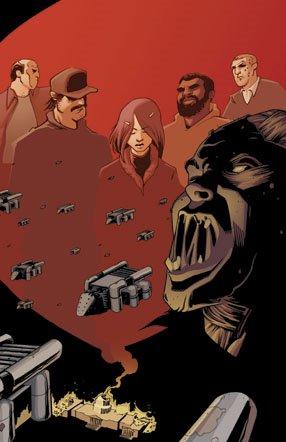
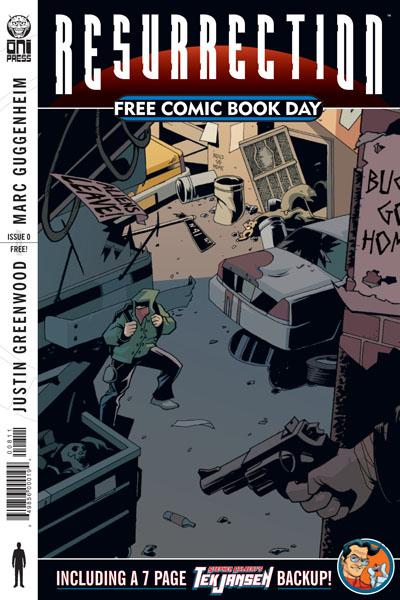
RESURRECTION: THE INSURGENT EDITION TPB & RESURRECTION #0 FCBD Edition
Writer: Mark Guggenheim Art: David Dumeer & Douglas Dabbs (TPB) & Juntin Greenwood (FCBD Edition) Publisher: Oni Press Reviewer: Ambush Bug
Most movies about the end of the world end on a bleak note. A plague hits, humanity slides off the table, and all of man's carefully built dreams are destroyed. Most zombie movies happen in that fashion, as do plague movies and even the recent disaster movies. Once the threat is revealed and battled, it goes one of two ways - towards hope or towards hell. Either way it follows a formula, one tried and true in both comics and films. The fun part has always been man's initial reaction to the sudden splash in the kiddie pool. RESURRECTION is what happens next. Although it specifically deals with an alien attack, it could easily be a zombie comic, or a nuclear war comic, or even a superhero origin story. What RESURRECTION does so well is that it tells you what happens AFTER all of the usual stuff goes on. Devastating alien attack. Mankind loses and retreats into bunkers. The world is conquered. End of movie, right?Nope, that's just the beginning of RESURRECTION. The trade paperback of RESURRECTION opens with the humans crawling out of bomb shelters to investigate something they haven't experienced in a long time--silence. What they find is an evacuated Earth. Almost all remnants of an alien attack are gone. There is much devastation. Cities are leveled, but not an alien to be seen, and so starts a story of picking up the pieces, and a trip down untried territory is launched.
RESURRECTION is rock solid storytelling. Writer Mark Guggenhiem writes as if he's experienced this stuff first hand. The PTSD of the survivors, the lack of control, the chaos, the lack of leadership: all of the things the government tries to keep society from doing have happened and a return to the good old days seems further and further away from the realm of possibility as each issue drops.
Guggenheim starts this miniseries off with a tight focus on one aspect of the story, a lone survivor wandering from a shelter and looking for her "missing" son, but as the issues go by, the camera pulls back to reveal more and more of a destroyed world and humanity’s often futile attempts to piece civilization back together. Like most strong fiction, this story is rich in metaphor reminiscent of national tragedies such as 9-11 and Hiroshima and Peal Harbor. The confusion and retreat that happened September 11th has been magnified here to sci fi levels, but the barbarism, the panic, and the cutthroat struggle for power, though intensified for fictional purposes in RESURRECTION, are not that different from the way the real world reacts to such tragedies.
What I really like about this trade is the focus on the struggle for power. Though the president and vice president have passed away, the secretary of state still lives and hopes to step into the leadership role. Much of this story focuses on the reaction of a small population to a man who was not elected into an office and the concept that if the nation that elected the leader no longer exists, does that leader have a right to lead? The attention to politics is another layer of cool in this multi-dimensional book.
If you've noticed, I haven't mentioned the aliens at all so far. Reason is, there really aren’t a lot of aliens in this book. But their presence is felt throughout in the shattered civilizations that decorate every panel and hopeless looks on the faces rendered crisply and cleanly by artists Dumeer & Dabbs. The one alien that is featured in this series only has a few panels dedicated to him in the collected trade, but these panels are doozies.
